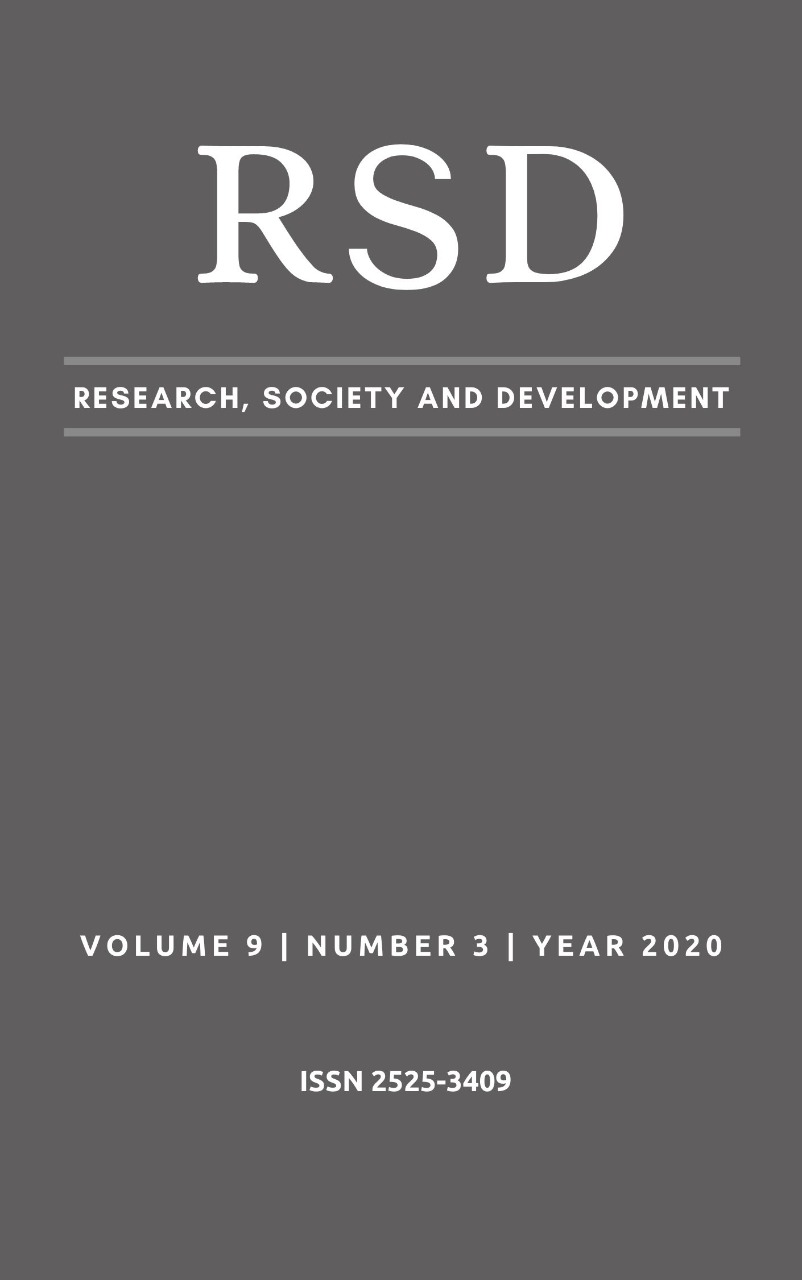Avaliação das condições de armazenamento da merenda escolar nas escolas da rede municipal da zona sudeste de Teresina-Piauí-Brasil
DOI:
https://doi.org/10.33448/rsd-v9i3.2554Palavras-chave:
Alimentos, Conservação, Manipulador.Resumo
Com esta pesquisa objetivou-se avaliar a origem e as condições de armazenamento da merenda escolar nas escolas da rede municipal da zona Sudeste de Teresina-Piauí-Brasil. A pesquisa foi realizada em 46 escolas, o questionário utilizado foi baseado no Roteiro de Inspeção do Armazenamento da Merenda Escolar da Prefeitura Municipal de Fortaleza, Ceará, os itens dos questionários foram agrupados, por assunto, em onze blocos. Observou-se que para o bloco recebimento da matéria-prima e organização da área de armazenamento verificou-se que apenas 42,0% (dez) e 50,0% (onze) das escolas do ensino infantil e fundamental, respectivamente, apresentam uma rede de frio adequado. Para o bloco condições físicas da área de armazenamento apenas 58,0% (quatorze) das escolas do ensino infantil e 82,0% (dezoito) do ensino fundamental possuem área exclusiva para armazenar alimentos. Para o bloco manipulador constatou-se que 46,0% (onze) e 91,0% (vinte) das merendeiras das escolas do ensino infantil e fundamental, respectivamente, usam o gorro e o avental para a manipulação dos alimentos. Nas palestras observou-se que de 46 escolas pesquisadas tivemos a participação de 76,0% (35 merendeiras). Dentre as principais irregularidades temos às condições de armazenamento de frios, um controle de pragas inexisten na área de estocagem, falta de existência de área física exclusiva para depósito dos mantimentos, estrutura física da área de armazenamento, principalmente, relacionado com os itens paredes e portas.
Referências
Brasil. Anvisa (2004). Diretoria Colegiada da Agência Nacional de Vigilância Sanitária. Dispõe sobre o Regulamento Técnico de Boas Praticas para Serviços de Alimentação. Resolução RDC nº 216, de 15 de setembro de 2004. Brasília.
Campos, J.; Rodriguez, C; Sterra, A (2003). Estúdio microbiológico de lãs comidas servidas em los comedores escolares de la islã de Tenerife. Revista Espanhola Salud Publica, México, v.77, n. 6, p. 749-760.
Cardoso, R.C.V.; et al. Programa nacional de alimentação escolar: há segurança na produção de alimentos em escolas de Salvador (Bahia), Rev.Nutr. Campinas, v.23, n.5, p.801-811, set/ out., 2010.
Ceará. (2007) Prefeitura Municipal de Fortaleza, Secretária Executiva Regional, Distrito de Saúde, Vigilância Sanitária e Ambiental. Roteiro de Inspeção das Boas Práticas de Armazenamentoe Preparo da merenda escolar.
Gomes, N. A. A. A; Barbosa, E.C.(2017) Avaliação das condições higienicossanitárias em Centro Municipal de Educação Infantil de Goiânia, GO. Revista Higiene Alimentar.Vol. 31 – n 272/272 – Setembro/Outubro
Leal Mendes, T. I., Santos Monteiro, M. L., Freitas de Carvalho, L. M., & Batista Bezerra, K. C. (2019). Condições higiênicas e sanitárias de unidades de alimentação e nutrição de escolas em tempo integral. Revista Eletrônica Acervo Saúde, (31), e1150. https://doi.org/10.25248/reas.e1150.2019
Oliveira, M.N.; Brasil, A.L.D.; Taddei, J.A.A.C. (2007). Avaliação das condições higiênico-sanitárias das cozinhas de creches públicas e filantrópicas. Revista Ciência e Saúde Coletiva.
OMS-Organização Mundial de Saúde. Foodborne disease: a focus for health education. Geneva; 2000.
Piragine, K.O. (2005). Aspectos higiênicos e sanitários do preparo da merenda escolar na rede estadual de ensino de Curitiba, 122 f. Tese de mestrado, Tecnologia de Alimentos, Universidade Federal do Paraná.
Richards, M.S.; Rittman, M.; Gilbert, T.T.; Opal, S.M.; Debuono, B.A.; Neill, RJ, (1993). Investigation of a Staphtlococcal Food Poisoning Outbreak in a Centralized School Lunch Program. Public Health Rep. 108: 765-771.
Rizzo, M. (2000) Em busca da qualidade total – Controle de Pragas APRAG. 3:9-10.
Schuller, L. (2001) Controle de pragas nos serviços de alimentação. In: Silva Jr EA da. Manual de Controle Higiênico-Sanitário em Alimentos. 4ª edição. São Paulo: Varela, p. 93-103.
Silva, C.; Germano, M.I.S.; Germano, P.M.L. (2003). Condições higiênico-sanitárias dos locais de preparação da merenda escolar da rede estadual de ensino em São Paulo, SP. Higiene Alimentar, São Paulo, v.17, n.110.
Tomich, R.G.P., Tomich, T.R., Amaral, C.A.A., Junqueira, R.G., Pereira, A.J.G. (2005) Metodologia para avaliação das boas práticas de fabricação em indústrias de pão de queijo. Revista Ciência e Tecnologia Alimentar. vol.25, nº1, pp. 115-120.
Trindade, N.S. C; Pinheiro, J.S.; Almeida, H.G.; Carvalho, K; Sobrinho, P.P.S.C. (2014) Qualidade bacteriológica e segurança alimentar em um progra-ma de alimentação escolar brasileiro. Rev Hospital de Nutrição, v.29, n.1
World Health Organization. (2017). Food safety. Acedido a 30 de julho, 2018, em http://www.who.int/en/news-room/fact-sheets/detail/food-safety
Downloads
Publicado
Edição
Seção
Licença
Autores que publicam nesta revista concordam com os seguintes termos:
1) Autores mantém os direitos autorais e concedem à revista o direito de primeira publicação, com o trabalho simultaneamente licenciado sob a Licença Creative Commons Attribution que permite o compartilhamento do trabalho com reconhecimento da autoria e publicação inicial nesta revista.
2) Autores têm autorização para assumir contratos adicionais separadamente, para distribuição não-exclusiva da versão do trabalho publicada nesta revista (ex.: publicar em repositório institucional ou como capítulo de livro), com reconhecimento de autoria e publicação inicial nesta revista.
3) Autores têm permissão e são estimulados a publicar e distribuir seu trabalho online (ex.: em repositórios institucionais ou na sua página pessoal) a qualquer ponto antes ou durante o processo editorial, já que isso pode gerar alterações produtivas, bem como aumentar o impacto e a citação do trabalho publicado.


